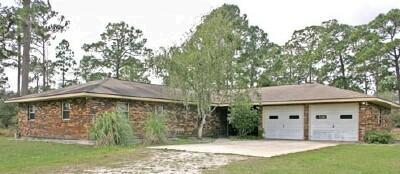

My wife and I had the good fortune to be able to stay for a week at the Archbold Biological Station located near Lake Placid, Florida. Our visit was during the week of March 6-12 2007, early in the moth season. Conditions were extremely dry with daytime temperatures approaching 80 F, and with mild nights with little wind. I had two purposes for going to Archbold in addition to escaping cold weather in Maryland. Having pored over the ABS moth checklist compiled by Marc Minno (large .pdf file) I hoped to photograph specimens in the ABS Reference Collection for species that were lacking on the MPG plates. And I of course wanted to spend evenings photographing living moths and also experimenting with mobile light sources for attracting them wherever I wanted to stop the car. For permission to conduct these activities at ABS I am grateful to the ABS Executive Director, Hilary M. Swain, and to Senior Research Biologist Mark A. Deyrup who heads the invertebrate biology lab and has charge of the insect collections.
ABS was established in 1941 and has been the site of much interesting research by staff and visiting scientists. Two kinds of studies that I had previously been aware of included a long-term and ongoing study of Florida Scrub Jays by Glen E. Woolfenden and associates. I had also read in Thomas Eisner's fine book, For Love of Insects, of numerous studies conducted over the years by him and his associates into the chemical biology of insects such as the Bella Moth. From my reading I knew that ABS preserved a large tract of Florida Scrub habitat at the southern terminus of the Lake Wales Ridge about 35 mile from the northern edge of Lake Okeechobee in the Kissimmee Prairie. The confluence of these biogeographical features offers the opportunity for finding endemic species, those that exist in a particular region and nowhere else. For a number of moth species this is home. To learn more about the regional ecological diversity and much about research at ABS, its programs, visitation and other topics, visit the Archbold Biological Station website.

 We were fortunate during our visit to be able to reside at modest cost in a 4-bedroom house owned by ABS and known as Jay House. It is located about two miles south of the main research complex and, except for the lack of telephone, TV and Internet connection, offered all the amenities of home - even a swimming pool! There are other cottages on the grounds and, depending on the nature and length of a planned visit, ABS might be able to accomodate you. There are of course motels and restaurants in the Lake Placid area a few miles away. During our visit I attached a sheet to a fence surrounding the swimming pool and ran a MV light there for a few hours each evening. I also spent one evening at Lake Annie, the only substantial water area on the property. And I used a blacklight on the roof of the car at several roadside locations.
We were fortunate during our visit to be able to reside at modest cost in a 4-bedroom house owned by ABS and known as Jay House. It is located about two miles south of the main research complex and, except for the lack of telephone, TV and Internet connection, offered all the amenities of home - even a swimming pool! There are other cottages on the grounds and, depending on the nature and length of a planned visit, ABS might be able to accomodate you. There are of course motels and restaurants in the Lake Placid area a few miles away. During our visit I attached a sheet to a fence surrounding the swimming pool and ran a MV light there for a few hours each evening. I also spent one evening at Lake Annie, the only substantial water area on the property. And I used a blacklight on the roof of the car at several roadside locations.
Because I wanted to spend a few hours each day in the ABS moth collection I spent less time mothing than might otherwise have been the case. Nevertheless, I was able to photograph about 94 species during our stay, and these included at least 21 species new for the MPG Living Moths Plates and, to my surprise, at least 8-9 species new for the ABS moth checklist. Not bad for extremely dry weather early in the moth year. In addition I was able to add from the ABS collection about 50 species to the MPG spread specimen plates. These are all shown on the following pages:
Spread Specimens | Micros through Pyralids | Geometrids through Noctuids | As Yet Unidentified Moths
I thank James Adams, Brian Scholtens and Jim Vargo for considerable assistance in the identification of these moths.
|
|





